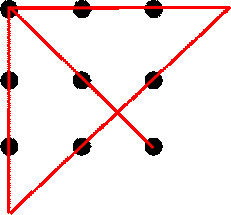What’s the Problem?
Charles Kettering - "A problem well defined is half solved."
Sometimes defining a problem is the key to its solution. The first step in solving any problem is understanding the problem. When this crucial first step is cast aside, the “would-be” problem-solvers rush in at full throttle contriving answers and solutions to perceived problems.
Collect facts that will help you understand the problem. Dig in. Ask questions. Break the facts down into manageable parts. Ask Why? Restate the problem. Think through the problem out loud.
Once the problem is understood, creativity techniques may be applied to come up with a solution.
Creativity Techniques
Creativity is applying original thought to a subject…a new idea. Creativity techniques provide us with ways to explore our experiences and apply them in new ways.
Fresh Eyes
“Fresh eyes” means finding a different way to look at something you are already familiar with. You may have used this technique without realizing it. Have you ever written a memo or letter (perhaps while you were in an irritated state) and then held on to it to review later? When you reviewed it later, were you relieved that you didn’t send it out the first time? You had given yourself a chance to “cool off” and review the note with a different mindset. You might still feel the same emotional attachment to the original words but you have tempered them by rationalizing the potentially negative impact of publishing them.
You hang a picture on the wall and it looks fine…until you take a few steps back and get a wider perspective on how well it lines up with the walls, the ceiling and the floor. Your “fresh eyes” tell you that you’re not finished yet.
Artists use this technique often. A painter might just take a few steps back from the painting to get a new perspective of what he has painted. He may walk a few steps away then glance back over his shoulder to catch a new perspective or take a few steps away then view his work in a mirror looking over his shoulder which reverses his artwork giving him fresh eyes. Each of these simple techniques gives him a fresh view of his work.
When you are immersed in a project, if you don’t step away from it every now and then, your mind may let you see the work as you want it to be rather that how it is. Raphael is said to have worked with an hourglass, never working longer than one hour at a time on any painting. James Michener established rigorous work habits; beginning each morning at 7:30, he sat on a hard wooden chair, used a manual typewriter, paper to the right, trash can to the left …and he always walked away from it at noon, coming back the next day with a fresh mind.
Operating people often work, in a sense, with blinders on. They don’t know what happens to the work before they get it and they don’t know what happens to it once it leaves their work area. As a member of a business process improvement team, they use process charts to see their work from a new vantage point. They see the steps they work on as part of a bigger picture. They see what happens to the work before they get it and they see what happens to the work when it leaves their work area. The process chart gives them the opportunity to see how changes made to the work they do could help or hinder work further down the process flow and they may suggest or support changes earlier on in the process that can make their work easier or more effective. The process chart can give people a sense of worth by showing the value they add to the process.
Videotape or film is a way for people to actually see themselves engaged in their work. Athletes, machine operators and surgeons are a sample of groups that have used film to help them improve their work. Allan Mogensen is recognized as the founder of work simplification – the organized application of common sense. He spent his career teaching people in organizations how to simplify their work. One of the tools he used was a motion picture camera. He would film a machine operator performing his work and then invite him to a private showing. The operator would see himself in action and invariably ask Mogensen two favors; “Please don’t show this to anyone.” And “May I do it again?” Mogensen was happy to oblige. He would ask the operator how much time he needed, and typically got a response like “How about an hour?” An hour later, Mogensen would re-film the operator. In the course of an hour or so, Mogensen would have before and after films documenting improved work methods (that typically measured 30-50% faster) simply by giving the operator “fresh eyes”.
Brainstorming
The concept of brainstorming is credited to Alex Osborn who described it in his book “Applied Imagination”. Brainstorming is used to quickly gather a large number of ideas about a specific topic by using the following guidelines:
· No criticism of ideas
· Go for large quantities of ideas
· Build on each others ideas
· Encourage wild and exaggerated ideas
Brainstorming is a group activity that includes a facilitator who leads the session, goes over the guidelines and ensures they are followed, and a recorder (or recorders) who captures ALL the ideas that are presented. Flipcharts, blackboards, whiteboards are helpful to keep the ideas visible in front of the group.
A brainstorming session is used to generate lots of ideas without evaluation. Therefore, it is essential to follow up the brainstorming session with analysis of the ideas that were generated.
Lateral Thinking
Edward DeBono coined the term lateral thinking which refers to problem solving through apparently illogical means by using techniques to jar normal thought patterns.
 In the exercise to the right, the challenge is to draw four straight lines through all the dots without lifting your pencil.
In the exercise to the right, the challenge is to draw four straight lines through all the dots without lifting your pencil.
In a normal approach, people tend to restrict themselves to lines that don’t extend outside the square. They are more comfortable with lines that connect 3 dots horizontally or vertically or diagonally through the center.
But, none of these will produce a solution!
They will not find a solution until they break through the bounds of the outside square and consider diagonals other than through the center.
They will not find a solution until they break through the bounds of the outside square and consider diagonals other than through the center.
 The solution is elegant and simple. It just requires that you recognize and break out of the self-imposed restraints that keep you focused in the wrong direction. This is the classic puzzle that was used by Allan Mogensen in his work simplification workshops beginning 70 years ago that led to the phrase “thinking outside the box.”
The solution is elegant and simple. It just requires that you recognize and break out of the self-imposed restraints that keep you focused in the wrong direction. This is the classic puzzle that was used by Allan Mogensen in his work simplification workshops beginning 70 years ago that led to the phrase “thinking outside the box.”
DeBono’s First Law - “You can’t dig a hole in a different place by digging the same hole deeper.”
Lateral thinking puzzles are very popular. They provide a scenario that requires explanation. The explanation is not obvious, but when provided, makes good sense.
These puzzles are often presented so that the solver can ask questions that can be answered yes, no or irrelevant.
Here is a classic – The Man in the Bar.
A man walks into a pub and asks the barman for a glass of water. The barman pulls out a gun and points it at the man. The man says 'Thank you' and walks out.
You will find the answer at the end of the article.
The puzzles that were just presented have specific answers. That’s not the case when the problem we are addressing is to come up with a new product, a new method, increased sales… Random word techniques can help us begin a lateral think exercise. We start with a word and see where it takes us…
The Yellow pages is a good source of random words. Hold the book loosely in one hand and let it fall open. Point your finger into the book and see where it falls. System Research Labs in Dayton, OH was a military contractor with 90% of their business with one client. Military cutbacks put them in a precarious situation. During a creativity workshop, a group used the yellow pages technique to start a session searching for alternative business opportunities. The finger landed on “Laundries”. Discussion started at laundries and moved on to highly-sterile laundry, to highly-sterile work environments, to hospital work to biometric devices. Biometric devices eventually became the most profitable division in the company.
The dictionary and magazines are other sources for random words. There is even random word generating software available.
Questioning Method
Rudyard Kipling – “I keep six honest serving-men (They taught me all I knew); their names are What and Why and When And How and Where and Who.” from The Elephant's Child
The questioning method helps us define existing situations and challenge them. Five of the questions (What, Who, When, Where and How) are objective with specific definable answers. “Why?” on the other hand is evaluative. When we ask these questions in a specific way (combining each of the descriptive questions with “Why?”), they are particularly useful for challenging work methods. When we ask the questions, "What is happening here and Why is it happening?” and we find no reasonable explanation, we have an opportunity to eliminate work. When we ask the questions, "When is this step done andWhy is it done at that time?", "Where is this done and Why is it done there?", "Who does this and Why does this person do it?" we may find opportunities to combine or rearrange the work.. When we ask the questions, "How it is done and Why do we do it that way", we find opportunities to redesign the work. The questioning method provides a structured format for generating ideas.
The man had hiccups. The barman recognized this from his speech and drew the gun in order to give him a shock. It worked and cured the hiccups - so the man no longer needed the water.











0 comments:
Post a Comment